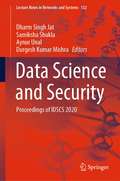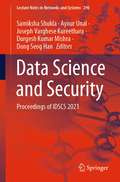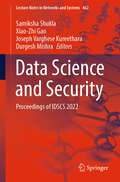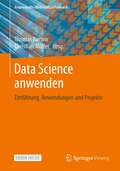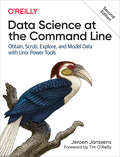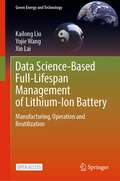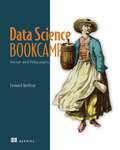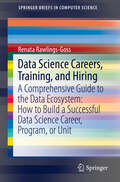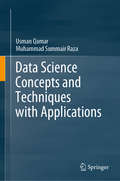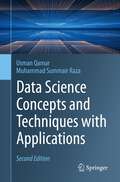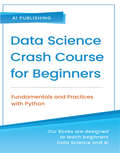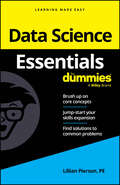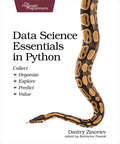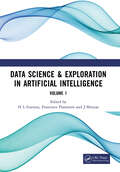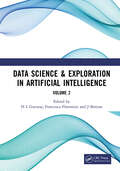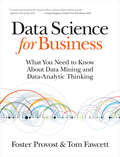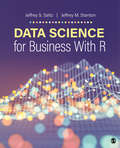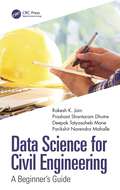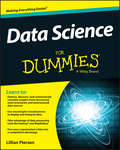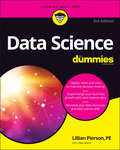- Table View
- List View
Data Science and Security: Proceedings of IDSCS 2020 (Lecture Notes in Networks and Systems #132)
by Durgesh Kumar Mishra Aynur Unal Dharm Singh Jat Samiksha ShuklaThis book presents best selected papers presented at the International Conference on Data Science for Computational Security (IDSCS 2020), organized by the Department of Data Science, CHRIST (Deemed to be University), Pune Lavasa Campus, India, during 13–14 March 2020. The proceeding will be targeting the current research works in the areas of data science, data security, data analytics, artificial intelligence, machine learning, computer vision, algorithms design, computer networking, data mining, big data, text mining, knowledge representation, soft computing and cloud computing.
Data Science and Security: Proceedings of IDSCS 2021 (Lecture Notes in Networks and Systems #290)
by Durgesh Kumar Mishra Aynur Unal Samiksha Shukla Joseph Varghese Kureethara Dong Seog HanThis book presents the best-selected papers presented at the International Conference on Data Science, Computation and Security (IDSCS-2021), organized by the Department of Data Science, CHRIST (Deemed to be University), Pune Lavasa Campus, India, during April 16–17, 2021. The proceeding is targeting the current research works in the areas of data science, data security, data analytics, artificial intelligence, machine learning, computer vision, algorithms design, computer networking, data mining, big data, text mining, knowledge representation, soft computing, and cloud computing.
Data Science and Security: Proceedings of IDSCS 2022 (Lecture Notes in Networks and Systems #462)
by Samiksha Shukla Xiao-Zhi Gao Joseph Varghese Kureethara Durgesh MishraThis book presents best selected papers presented at the International Conference on Data Science for Computational Security (IDSCS 2022), organized by the Department of Data Science, CHRIST (Deemed to be University), Pune Lavasa Campus, India, during 11 – 12 February 2022. The book proposes new technologies and discusses future solutions and applications of data science, data analytics and security. The book targets current research works in the areas of data science, data security, data analytics, artificial intelligence, machine learning, computer vision, algorithms design, computer networking, data mining, big data, text mining, knowledge representation, soft computing and cloud computing.
Data Science and Social Research II: Methods, Technologies and Applications (Studies in Classification, Data Analysis, and Knowledge Organization)
by Paolo Mariani Mariangela ZengaThe peer-reviewed contributions gathered in this book address methods, software and applications of statistics and data science in the social sciences. The data revolution in social science research has not only produced new business models, but has also provided policymakers with better decision-making support tools. In this volume, statisticians, computer scientists and experts on social research discuss the opportunities and challenges of the social data revolution in order to pave the way for addressing new research problems. The respective contributions focus on complex social systems and current methodological advances in extracting social knowledge from large data sets, as well as modern social research on human behavior and society using large data sets. Moreover, they analyze integrated systems designed to take advantage of new social data sources, and discuss quality-related issues. The papers were originally presented at the 2nd International Conference on Data Science and Social Research, held in Milan, Italy, on February 4-5, 2019.
Data Science and Visual Computing (Advanced Information and Knowledge Processing)
by Rae Earnshaw John Dill David KasikData science addresses the need to extract knowledge and information from data volumes, often from real-time sources in a wide variety of disciplines such as astronomy, bioinformatics, engineering, science, medicine, social science, business, and the humanities. The range and volume of data sources has increased enormously over time, particularly those generating real-time data. This has posed additional challenges for data management and data analysis of the data and effective representation and display. A wide range of application areas are able to benefit from the latest visual tools and facilities. Rapid analysis is needed in areas where immediate decisions need to be made. Such areas include weather forecasting, the stock exchange, and security threats. In areas where the volume of data being produced far exceeds the current capacity to analyze all of it, attention is being focussed how best to address these challenges. Optimum ways of addressing large data sets across a variety of disciplines have led to the formation of national and institutional Data Science Institutes and Centers. Being driven by national priority, they are able to attract support for research and development within their organizations and institutions to bring together interdisciplinary expertise to address a wide variety of problems. Visual computing is a set of tools and methodologies that utilize 2D and 3D images to extract information from data. Such methods include data analysis, simulation, and interactive exploration. These are analyzed and discussed.
Data Science anwenden: Einführung, Anwendungen und Projekte (Angewandte Wirtschaftsinformatik)
by Thomas Barton Christian MüllerDieses Buch bietet einen Einstieg in das Thema Data Science auf Basis der visuellen Aufbereitung von Daten. Es hat ethische Betrachtungen in der digitalen Transformation zum Gegenstand und stellt ein Prozessrahmenwerk für die Bewertung von Technologien vor. Außerdem erläutert es Besonderheiten und Erkenntnisse zum Scheitern von Data-Science-Projekten und stellt Empfehlungssysteme unter Berücksichtigung aktueller Entwicklungen vor. Funktionalität zu Machine Learning in Werkzeugen zu Business Analytics wird verglichen und der Einsatz eines Vorgehensmodells für Data Science aufgezeigt.Die Integration erneuerbarer Energien am Beispiel von Photovoltaikanlagen, ein effizienterer Umgang mit Wärmeenergie, wissenschaftliche Literaturauswertung, Kundenzufriedenheit in der Automobilindustrie und ein Framework für die Analyse von Fahrzeugdaten dienen als Anwendungsbeispiele für den konkreten Einsatz von Data Science. Das Buch bietet wichtige Informationen, die für Praktiker ebenso relevant sind wie für Studierende und Lehrende.
Data Science at Target
by Caitlin N. Bowler Srikant M. Datar<p>Paritosh Desai joined Target.com in 2013 as VP of Business Intelligence, Analytics & Testing to explore how the retailer could use its relatively small but thriving e-commerce arm to drive sales and win customers. The case explores the technological and organizational challenges Desai faced and the trade offs he considered in his four-year journey to develop the larger retail business into a data science organization. <p>Professor Srikant M. Datar and Research Associate Caitlin N. Bowler prepared this case. It was reviewed and approved before publication by a company designate. Funding for the development of this case was provided by Harvard Business School and not by the company. The citation review for this case has not yet been completed. HBS cases are developed solely as the basis for class discussion. Cases are not intended to serve as endorsements, sources of primary data, or illustrations of effective or ineffective management.</p>
Data Science at the Command Line
by Jeroen JanssensThis hands-on guide demonstrates how the flexibility of the command line can help you become a more efficient and productive data scientist. You'll learn how to combine small, yet powerful, command-line tools to quickly obtain, scrub, explore, and model your data.To get you started--whether you're on Windows, OS X, or Linux--author Jeroen Janssens introduces the Data Science Toolbox, an easy-to-install virtual environment packed with over 80 command-line tools.Discover why the command line is an agile, scalable, and extensible technology. Even if you're already comfortable processing data with, say, Python or R, you'll greatly improve your data science workflow by also leveraging the power of the command line.Obtain data from websites, APIs, databases, and spreadsheetsPerform scrub operations on plain text, CSV, HTML/XML, and JSONExplore data, compute descriptive statistics, and create visualizationsManage your data science workflow using DrakeCreate reusable tools from one-liners and existing Python or R codeParallelize and distribute data-intensive pipelines using GNU ParallelModel data with dimensionality reduction, clustering, regression, and classification algorithms
Data Science at the Command Line: Obtain, Scrub, Explore, and Model Data with Unix Power Tools
by Jeroen JanssensThis thoroughly revised guide demonstrates how the flexibility of the command line can help you become a more efficient and productive data scientist. You'll learn how to combine small yet powerful command-line tools to quickly obtain, scrub, explore, and model your data. To get you started, author Jeroen Janssens provides a Docker image packed with over 100 Unix power tools--useful whether you work with Windows, macOS, or Linux.You'll quickly discover why the command line is an agile, scalable, and extensible technology. Even if you're comfortable processing data with Python or R, you'll learn how to greatly improve your data science workflow by leveraging the command line's power. This book is ideal for data scientists, analysts, engineers, system administrators, and researchers.Obtain data from websites, APIs, databases, and spreadsheetsPerform scrub operations on text, CSV, HTML, XML, and JSON filesExplore data, compute descriptive statistics, and create visualizationsManage your data science workflowCreate your own tools from one-liners and existing Python or R codeParallelize and distribute data-intensive pipelinesModel data with dimensionality reduction, regression, and classification algorithmsLeverage the command line from Python, Jupyter, R, RStudio, and Apache Spark
Data Science-Based Full-Lifespan Management of Lithium-Ion Battery: Manufacturing, Operation and Reutilization (Green Energy and Technology)
by Kailong Liu Yujie Wang Xin LaiThis open access book comprehensively consolidates studies in the rapidly emerging field of battery management. The primary focus is to overview the new and emerging data science technologies for full-lifespan management of Li-ion batteries, which are categorized into three groups, namely (i) battery manufacturing management, (ii) battery operation management, and (iii) battery reutilization management. The key challenges, future trends as well as promising data-science technologies to further improve this research field are discussed. As battery full-lifespan (manufacturing, operation, and reutilization) management is a hot research topic in both energy and AI fields and none specific book has focused on systematically describing this particular from a data science perspective before, this book can attract the attention of academics, scientists, engineers, and practitioners. It is useful as a reference book for students and graduates working in related fields. Specifically, the audience could not only get the basics of battery manufacturing, operation, and reutilization but also the information of related data-science technologies. The step-by-step guidance, comprehensive introduction, and case studies to the topic make it accessible to audiences of different levels, from graduates to experienced engineers.
Data Science Bookcamp: Five real-world Python projects
by Leonard ApeltsinLearn data science with Python by building five real-world projects! Experiment with card game predictions, tracking disease outbreaks, and more, as you build a flexible and intuitive understanding of data science.In Data Science Bookcamp you will learn: - Techniques for computing and plotting probabilities - Statistical analysis using Scipy - How to organize datasets with clustering algorithms - How to visualize complex multi-variable datasets - How to train a decision tree machine learning algorithm In Data Science Bookcamp you&’ll test and build your knowledge of Python with the kind of open-ended problems that professional data scientists work on every day. Downloadable data sets and thoroughly-explained solutions help you lock in what you&’ve learned, building your confidence and making you ready for an exciting new data science career. Purchase of the print book includes a free eBook in PDF, Kindle, and ePub formats from Manning Publications. About the technology A data science project has a lot of moving parts, and it takes practice and skill to get all the code, algorithms, datasets, formats, and visualizations working together harmoniously. This unique book guides you through five realistic projects, including tracking disease outbreaks from news headlines, analyzing social networks, and finding relevant patterns in ad click data. About the book Data Science Bookcamp doesn&’t stop with surface-level theory and toy examples. As you work through each project, you&’ll learn how to troubleshoot common problems like missing data, messy data, and algorithms that don&’t quite fit the model you&’re building. You&’ll appreciate the detailed setup instructions and the fully explained solutions that highlight common failure points. In the end, you&’ll be confident in your skills because you can see the results. What's inside - Web scraping - Organize datasets with clustering algorithms - Visualize complex multi-variable datasets - Train a decision tree machine learning algorithm About the reader For readers who know the basics of Python. No prior data science or machine learning skills required. About the author Leonard Apeltsin is the Head of Data Science at Anomaly, where his team applies advanced analytics to uncover healthcare fraud, waste, and abuse. Table of Contents CASE STUDY 1 FINDING THE WINNING STRATEGY IN A CARD GAME 1 Computing probabilities using Python 2 Plotting probabilities using Matplotlib 3 Running random simulations in NumPy 4 Case study 1 solution CASE STUDY 2 ASSESSING ONLINE AD CLICKS FOR SIGNIFICANCE 5 Basic probability and statistical analysis using SciPy 6 Making predictions using the central limit theorem and SciPy 7 Statistical hypothesis testing 8 Analyzing tables using Pandas 9 Case study 2 solution CASE STUDY 3 TRACKING DISEASE OUTBREAKS USING NEWS HEADLINES 10 Clustering data into groups 11 Geographic location visualization and analysis 12 Case study 3 solution CASE STUDY 4 USING ONLINE JOB POSTINGS TO IMPROVE YOUR DATA SCIENCE RESUME 13 Measuring text similarities 14 Dimension reduction of matrix data 15 NLP analysis of large text datasets 16 Extracting text from web pages 17 Case study 4 solution CASE STUDY 5 PREDICTING FUTURE FRIENDSHIPS FROM SOCIAL NETWORK DATA 18 An introduction to graph theory and network analysis 19 Dynamic graph theory techniques for node ranking and social network analysis 20 Network-driven supervised machine learning 21 Training linear classifiers with logistic regression 22 Training nonlinear classifiers with decision tree techniques 23 Case study 5 solution
Data Science Careers, Training, and Hiring: A Comprehensive Guide to the Data Ecosystem: How to Build a Successful Data Science Career, Program, or Unit (SpringerBriefs in Computer Science)
by Renata Rawlings-GossThis book is an information packed overview of how to structure a data science career, a data science degree program, and how to hire a data science team, including resources and insights from the authors experience with national and international large-scale data projects as well as industry, academic and government partnerships, education, and workforce. Outlined here are tips and insights into navigating the data ecosystem as it currently stands, including career skills, current training programs, as well as practical hiring help and resources. Also, threaded through the book is the outline of a data ecosystem, as it could ultimately emerge, and how career seekers, training programs, and hiring managers can steer their careers, degree programs, and organizations to align with the broader future of data science. Instead of riding the current wave, the author ultimately seeks to help professionals, programs, and organizations alike prepare a sustainable plan for growth in this ever-changing world of data. The book is divided into three sections, the first “Building Data Careers”, is from the perspective of a potential career seeker interested in a career in data, the second “Building Data Programs” is from the perspective of a newly forming data science degree or training program, and the third “Building Data Talent and Workforce” is from the perspective of a Data and Analytics Hiring Manager. Each is a detailed introduction to the topic with practical steps and professional recommendations. The reason for presenting the book from different points of view is that, in the fast-paced data landscape, it is helpful to each group to more thoroughly understand the desires and challenges of the other. It will, for example, help the career seekers to understand best practices for hiring managers to better position themselves for jobs. It will be invaluable for data training programs to gain the perspective of career seekers, who they want to help and attract as students. Also, hiring managers will not only need data talent to hire, but workforce pipelines that can only come from partnerships with universities, data training programs, and educational experts. The interplay gives a broader perspective from which to build.
Data Science Concepts and Techniques with Applications
by Usman Qamar Muhammad Summair RazaThis book comprehensively covers the topic of data science. Data science is an umbrella term that encompasses data analytics, data mining, machine learning, and several other related disciplines. This book synthesizes both fundamental and advanced topics of a research area that has now reached maturity. The chapters of this book are organized into three sections:The first section is an introduction to data science. Starting from the basic concepts, the book will highlight the types of data, its use, its importance and issues that are normally faced in data analytics. Followed by discussion on wide range of applications of data science and widely used techniques in data science.The second section is devoted to the tools and techniques of data science. It consists of data pre-processing, feature selection, classification and clustering concepts as well as an introduction to text mining and opining mining.And finally, the third section of the book focuses on two programming languages commonly used for data science projects i.e. Python and R programming language.Although this book primarily serves as a textbook, it will also appeal to industrial practitioners and researchers due to its focus on applications and references. The book is suitable for both undergraduate and postgraduate students as well as those carrying out research in data science. It can be used as a textbook for undergraduate students in computer science, engineering and mathematics. It can also be accessible to undergraduate students from other areas with the adequate background. The more advanced chapters can be used by postgraduate researchers intending to gather a deeper theoretical understanding.
Data Science Concepts and Techniques with Applications
by Usman Qamar Muhammad Summair RazaThis textbook comprehensively covers both fundamental and advanced topics related to data science. Data science is an umbrella term that encompasses data analytics, data mining, machine learning, and several other related disciplines. The chapters of this book are organized into three parts: The first part (chapters 1 to 3) is a general introduction to data science. Starting from the basic concepts, the book will highlight the types of data, its use, its importance and issues that are normally faced in data analytics, followed by presentation of a wide range of applications and widely used techniques in data science. The second part, which has been updated and considerably extended compared to the first edition, is devoted to various techniques and tools applied in data science. Its chapters 4 to 10 detail data pre-processing, classification, clustering, text mining, deep learning, frequent pattern mining, and regression analysis. Eventually, the third part (chapters 11 and 12) present a brief introduction to Python and R, the two main data science programming languages, and shows in a completely new chapter practical data science in the WEKA (Waikato Environment for Knowledge Analysis), an open-source tool for performing different machine learning and data mining tasks. An appendix explaining the basic mathematical concepts of data science completes the book. This textbook is suitable for advanced undergraduate and graduate students as well as for industrial practitioners who carry out research in data science. They both will not only benefit from the comprehensive presentation of important topics, but also from the many application examples and the comprehensive list of further readings, which point to additional publications providing more in-depth research results or provide sources for a more detailed description of related topics. "This book delivers a systematic, carefully thoughtful material on Data Science." from the Foreword by Witold Pedrycz, U Alberta, Canada.
Data Science Crash Course for Beginners: Learn data science fast with this practical guide
by AI Sciences OUThis course lays the groundwork for further study into data science with Python for those students with little to no experienceKey FeaturesCrash course in Python programming to build or refresh any gaps in prerequisite knowledgeReal-world projects for hands-on practice in various data science tasksAccess to all codes and datasets free to view onlineBook DescriptionData science is here to stay. The tremendous growth in the volume, velocity, and variety of data has a substantial impact on every aspect of a business. While data continues to grow exponentially, accuracy remains a problem. This is where data scientists play a decisive role.A data scientist analyzes data, discovers new insights, paints a picture, and creates a vision. And a competent data scientist will provide a business with the competitive edge it needs and to address pressing business problems.Data Science Crash Course for Beginners with Python presents you with a hands-on approach to learn data science fast. This book presents you with the tools and packages you need to kick-start data science projects to resolve problems of a practical nature. Special emphasis is laid on the main stages of a data science pipeline—data acquisition, data preparation, exploratory data analysis, data modeling and evaluation, and interpretation of the results.The author simplifies your learning by providing detailed, guided instructions through everything. The step-by-step description of the installation of the software you need to implement the various data science techniques in this book is guaranteed to make your learning easier. So, right from the beginning, you can experiment with the practical aspects of data science. By the end of this course, you will have a solid grasp on the essential concepts of data science and its most fundamental implementations, laying the groundwork for your next steps no matter your chosen direction.The code bundle for this course is available at https://www.aispublishing.net/book-data-science-01What you will learnConsider Natural Language Processing and decision making in data scienceInstall Python and libraries for data scienceReview Python for data scienceStudy data acquisitionPractice data preparation (preprocessing)Perform exploratory data analysisExplore data modeling and evaluation using machine learningInterpret data and report your findingsSuccessfully complete several data science projectsWho this book is forThis book is specifically designed for beginners in data science looking to build foundational tools and skills quickly, utilizing the Python programming language. No prior experience is required.
Data Science Essentials For Dummies
by Lillian PiersonFeel confident navigating the fundamentals of data science Data Science Essentials For Dummies is a quick reference on the core concepts of the exploding and in-demand data science field, which involves data collection and working on dataset cleaning, processing, and visualization. This direct and accessible resource helps you brush up on key topics and is right to the point—eliminating review material, wordy explanations, and fluff—so you get what you need, fast. Strengthen your understanding of data science basics Review what you've already learned or pick up key skills Effectively work with data and provide accessible materials to others Jog your memory on the essentials as you work and get clear answers to your questions Perfect for supplementing classroom learning, reviewing for a certification, or staying knowledgeable on the job, Data Science Essentials For Dummies is a reliable reference that's great to keep on hand as an everyday desk reference.
Data Science Essentials in Python: Collect - Organize - Explore - Predict - Value
by Dmitry ZinovievGo from messy, unstructured artifacts stored in SQL and NoSQL databases to a neat, well-organized dataset with this quick reference for the busy data scientist. Understand text mining, machine learning, and network analysis; process numeric data with the NumPy and Pandas modules; describe and analyze data using statistical and network-theoretical methods; and see actual examples of data analysis at work. This one-stop solution covers the essential data science you need in Python.Data science is one of the fastest-growing disciplines in terms of academic research, student enrollment, and employment. Python, with its flexibility and scalability, is quickly overtaking the R language for data-scientific projects. Keep Python data-science concepts at your fingertips with this modular, quick reference to the tools used to acquire, clean, analyze, and store data.This one-stop solution covers essential Python, databases, network analysis, natural language processing, elements of machine learning, and visualization. Access structured and unstructured text and numeric data from local files, databases, and the Internet. Arrange, rearrange, and clean the data. Work with relational and non-relational databases, data visualization, and simple predictive analysis (regressions, clustering, and decision trees). See how typical data analysis problems are handled. And try your hand at your own solutions to a variety of medium-scale projects that are fun to work on and look good on your resume.Keep this handy quick guide at your side whether you're a student, an entry-level data science professional converting from R to Python, or a seasoned Python developer who doesn't want to memorize every function and option.What You Need:You need a decent distribution of Python 3.3 or above that includes at least NLTK, Pandas, NumPy, Matplotlib, Networkx, SciKit-Learn, and BeautifulSoup. A great distribution that meets the requirements is Anaconda, available for free from www.continuum.io. If you plan to set up your own database servers, you also need MySQL (www.mysql.com) and MongoDB (www.mongodb.com). Both packages are free and run on Windows, Linux, and Mac OS.
Data Science & Exploration in Artificial Intelligence: Proceedings of the First International Conference On Data Science & Exploration in Artificial Intelligence (CODE-AI 2024) Bangalore, India, 3rd- 4th July, 2024 (Volume 1)
by H. L. Gururaj Francesco Flammini J. ShreyasThe book captures the essence of the International Conference on Data Science & Exploration in Artificial Intelligence and offers a comprehensive exploration of cutting-edge research in AI, data science, and their applications.It covers a wide array of topics including advanced Data Science, IoT, Security, Cloud Computing, Networks, Security, Image, Video and Signal Processing, Computational Biology, Computer and Information Technology. It highlights innovative research contributions and practical applications, offering readers a detailed understanding of current trends and challenges. The findings emphasize the role of global collaboration and interdisciplinary approaches in pushing the boundaries of AI and data science. Selected papers published by Taylor and Francis showcase pioneering work that is shaping the future of these fields.This is an ideal read for AI and data science researchers, industry professionals, and students seeking to stay updated on the latest advancements and ethical considerations in these areas.
Data Science & Exploration in Artificial Intelligence: Proceedings of the First International Conference On Data Science & Exploration in Artificial Intelligence (CODE-AI 2024) Bangalore, India, 3rd- 4th July, 2024 (Volume 2)
by H. L. Gururaj Francesco Flammini J. ShreyasThe book captures the essence of the International Conference on Data Science & Exploration in Artificial Intelligence and offers a comprehensive exploration of cutting-edge research in AI, data science, and their applications.It covers a wide array of topics including advanced Data Science, IoT, Security, Cloud Computing, Networks, Security, Image, Video and Signal Processing, Computational Biology, Computer and Information Technology. It highlights innovative research contributions and practical applications, offering readers a detailed understanding of current trends and challenges. The findings emphasize the role of global collaboration and interdisciplinary approaches in pushing the boundaries of AI and data science. Selected papers published by Taylor and Francis showcase pioneering work that is shaping the future of these fields.This is an ideal read for AI and data science researchers, industry professionals, and students seeking to stay updated on the latest advancements and ethical considerations in these areas.
Data Science for Business: What You Need to Know about Data Mining and Data-Analytic Thinking
by Foster Provost Tom FawcettWritten by renowned data science experts Foster Provost and Tom Fawcett, Data Science for Business introduces the fundamental principles of data science, and walks you through the "data-analytic thinking" necessary for extracting useful knowledge and business value from the data you collect. This guide also helps you understand the many data-mining techniques in use today.Based on an MBA course Provost has taught at New York University over the past ten years, Data Science for Business provides examples of real-world business problems to illustrate these principles. You’ll not only learn how to improve communication between business stakeholders and data scientists, but also how participate intelligently in your company’s data science projects. You’ll also discover how to think data-analytically, and fully appreciate how data science methods can support business decision-making.Understand how data science fits in your organization—and how you can use it for competitive advantageTreat data as a business asset that requires careful investment if you’re to gain real valueApproach business problems data-analytically, using the data-mining process to gather good data in the most appropriate wayLearn general concepts for actually extracting knowledge from dataApply data science principles when interviewing data science job candidates
Data Science for Business With R
by Jeffrey S. Saltz Jeffrey Morgan StantonData Science for Business with R, written by Jeffrey S. Saltz and Jeffrey M. Stanton, focuses on the concepts foundational for students starting a business analytics or data science degree program. To keep the book practical and applied, the authors feature a running case using a global airline business’s customer survey dataset to illustrate how to turn data in business decisions, in addition to numerous examples throughout. To aid in usability beyond the classroom, the text features full integration of freely-available R and RStudio software, one of the most popular data science tools available. Designed for students with little to no experience in related areas like computer science, the book chapters follow a logical order from introduction and installation of R and RStudio, working with data architecture, undertaking data collection, performing data analysis, and transitioning to data archiving and presentation. Each chapter follows a familiar structure, starting with learning objectives and background, following the basic steps of functions alongside simple examples, applying these functions to the case study, and ending with chapter challenge questions, sources, and a list of R functions so students know what to expect in each step of their data science course. Data Science for Business with R provides readers with a straightforward and applied guide to this new and evolving field.
Data Science for Business With R
by Jeffrey S. Saltz Jeffrey Morgan StantonData Science for Business with R, written by Jeffrey S. Saltz and Jeffrey M. Stanton, focuses on the concepts foundational for students starting a business analytics or data science degree program. To keep the book practical and applied, the authors feature a running case using a global airline business’s customer survey dataset to illustrate how to turn data in business decisions, in addition to numerous examples throughout. To aid in usability beyond the classroom, the text features full integration of freely-available R and RStudio software, one of the most popular data science tools available. Designed for students with little to no experience in related areas like computer science, the book chapters follow a logical order from introduction and installation of R and RStudio, working with data architecture, undertaking data collection, performing data analysis, and transitioning to data archiving and presentation. Each chapter follows a familiar structure, starting with learning objectives and background, following the basic steps of functions alongside simple examples, applying these functions to the case study, and ending with chapter challenge questions, sources, and a list of R functions so students know what to expect in each step of their data science course. Data Science for Business with R provides readers with a straightforward and applied guide to this new and evolving field.
Data Science for Civil Engineering: A Beginner's Guide
by Rakesh K. Jain Prashant Shantaram Dhotre Deepak Tatyasaheb Mane Parikshit Narendra MahalleThis book explains use of data science-based techniques for modeling and providing optimal solutions to complex problems in civil engineering. It discusses civil engineering problems like air, water and land pollution, climate crisis, transportation infrastructures, traffic and travel modes, mobility services, and so forth. Divided into two sections, the first one deals with the basics of data science and essential mathematics while the second section covers pertinent applications in structural and environmental engineering, construction management, and transportation. Features: Details information on essential mathematics required to implement civil engineering applications using data science techniques. Discusses broad background of data science and its fundamentals. Focusses on structural engineering, transportation systems, water resource management, geomatics, and environmental engineering. Includes python programming libraries to solve complex problems. Addresses various real-world applications of data science based civil engineering use cases. This book aims at senior undergraduate students in Civil Engineering and Applied Data Science.
Data Science For Dummies
by Lillian PiersonDiscover how data science can help you gain in-depth insight into your business - the easy way! Jobs in data science abound, but few people have the data science skills needed to fill these increasingly important roles in organizations. Data Science For Dummies is the perfect starting point for IT professionals and students interested in making sense of their organization's massive data sets and applying their findings to real-world business scenarios. From uncovering rich data sources to managing large amounts of data within hardware and software limitations, ensuring consistency in reporting, merging various data sources, and beyond, you'll develop the know-how you need to effectively interpret data and tell a story that can be understood by anyone in your organization. Provides a background in data science fundamentals before moving on to working with relational databases and unstructured data and preparing your data for analysis Details different data visualization techniques that can be used to showcase and summarize your data Explains both supervised and unsupervised machine learning, including regression, model validation, and clustering techniques Includes coverage of big data processing tools like MapReduce, Hadoop, Dremel, Storm, and Spark It's a big, big data world out there - let Data Science For Dummies help you harness its power and gain a competitive edge for your organization.
Data Science For Dummies
by Lillian PiersonMake smart business decisions with your data by design! Take a deep dive to understand how developing your data science dogma can drive your business—ya dig? Every phone, tablet, computer, watch, and camera generates data—we’re overwhelmed with the stuff. That’s why it’s become increasingly important that you know how to derive useful insights from the data you have to understand which piece of data in the sea of data is important and which isn’t (trust us: not as scary as it sounds!), and to rely on said data to make critical business decisions. Enter the world of data science: the practice of using scientific methods, processes, and algorithms to gain knowledge and insights from any type of data. Data Science For Dummies provides a comprehensive introduction in that friendly and approachable way you’ve come to know from Dummies. Your new go-to guide breaks down this vast topic into three smaller parts—big data, data science, and data engineering—and then shows you how to combine those areas to produce value and make informed decisions to drive business growth. It’s also filled with real-world examples and applications that you can apply to your situation. Data Science For Dummies demonstrates: How natural language processing works Strategies around data science How to make decisions using probabilities Ways to display your data using a visualization model How to incorporate various programming languages into your strategy Whether you’re a professional or a student, Data Science For Dummies will get you caught up on all the latest data trends. Find out how to ask the pressing questions you need your data to answer by picking up your copy today.
